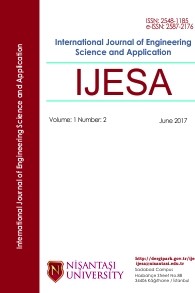A Versatile Wave Propagation Model for Very High Frequency Broadcasting Band in Vegetation and/or Rocky Environment
A Versatile Wave Propagation Model for Very High Frequency Broadcasting Band in Vegetation and/or Rocky Environment
___
- [1] T. Rick, and R. Mathar, “Fast edge-diffraction-based radio wave propagation model for graphics hardware”, Proceedings of the 2nd IEEE International ITG Conference on Antenna (INICA), Munich, Germany, 2007, DOI: 10.1109/INICA.2007.
- [2] K.J. Parmar, and V.D. Nimavat. “Comparative analysis of path loss propagation models in radio communication”, International Journal of Innovative Research in Computer and Communication Engineering, Vol. 3, No. 2, pp. 840-844, 2015.
- [3] J.B. Andersen, T.S. Rappaport, and S. Yoshida, “Propagation measurements and models for wireless communications channels”, IEEE Communications Magazine, Vol. 33, No. 1, pp. 42-49, 1995.
- [4] S. Joshi, “Outdoor propagation models a literature review”, International Journal on Computer Science and Engineering, Vol. 4, No. 2, pp. 281-291, 2012.
- [5] T.K. Sarkar, Z. Ji, K. Kim, A. Medour, and M. Salazar-Palma, “A survey of various propagation models for mobile communication”, IEEE Antennas and Propagation Magazine, Vol. 45, No. 3, pp. 51-82, 2003.
- [6] P. Rani, V. Chauhan, S. Kumar, and D. Sharma, “A review on wireless propagation models”, International Journal of Engineering and Innovative, Vol. 3, No. 11, pp. 256-261, 2014.
- [7] J. Milanovic, S. Rimac-Drlje, and I. Majerski, “Radio wave propagation mechanisms and empirical models for fixed wireless access systems”, Technical Gazette, Vol. 17, No. 1, pp. 43-52, 2010.
- [8] M.F. Iskander, and Z. Yun, “Propagation prediction models for wireless communication systems”, IEEE Transactions on Microwave Theory and Techniques, Vol. 50 , No.3, pp. 662-673, 2002.
- [9] M.O. Ajewole, O.D. Oyedun, A.T. Adediji, A.S. Moses, and J.O. Eiche, “Spatial variability of VHF/UHF electric field strength in Niger State, Nigeria, International Journal of Digital Information and Wireless Communications, Vol. 3, No. 3, pp. 231-239, 2013.
- [10] NBC, Nigeria Broadcasting Code. 2002, p.1-196. Available at: http://www.nbc.gov.ng/uploads/nbc_documents/1466685527-code%20third%20edition.pdf, Retrieved January 24, 2017.
- [11] A. Obot, O. Simeon, and J. Afolabi, “Comparative analysis of path loss prediction models for urban macrocellular environments”, Nigeria Journal of Technology, Vol. 30, No. 3, pp. 50-59, 2011.
- [12] C. Temaneh-Nyah, and J. Nepembe, “Determination of a suitable correction factor to a radio propagation model for cellular wireless network analysis”, Proceedings of 5th IEEE International Conference on Intelligent Systems, Modelling and Simulation, Langkawi, Malaysia, p.175-82, 27-29 January 2014.
- [13] P.K. Sharma, and R.K. Singh “Comparative analysis of propagation path loss models with field measured data,” International Journal of Engineering Science and Technology, Vol. 2, No. 6, pp. 2008-2013, 2010.
- [14] J.C. Ogbulezie, M.C. Onuu, D.C. Bassey, and S. Etienam-Umoh, “Site specific measurements and propagation models for gsm in three cities in Northern Nigeria, American Journal Journal of Scientific and Industrial Research, Vol. 4, No. 2, pp. 238-245, 2013.
- [15] V.S. Abhayawardhana, I.J. Wassell, D. Crosby, M.P. Sellars, and M.G. Brown “Comparison of empirical propagation path loss models for fixed wireless access systems”, Proceedings of 61st IEEE Vehicular Technology Conference, Stockholm, Sweden, pp. 73-77, 30 May-1 June 2005.
- [16] G.E. Athanasiadou, A.R. Nix, and J.P. Mcgeehan, “A microcellular ray-tracing propagation model and evaluation of its narrowband and wideband predictions”, IEEE Journal on Selected Areas in Communications, Wireless Communications Series, Vol. 18, 2000.
- [17] P.T.Z. Tun, and A.S. Hlaing, “Modification of propagation prediction model for 2.4 GHz indoor wireless environment”, Proceedings of International Conference on Advances in Engineering and Technology, Singapore, p. 360-64, 29-30 March 2014.
- [18] Z. Nadir, N. Elfadhil, and F. Touati “Pathloss determination using Okumura-Hata model and spline interpolation for missing data for Oman”, Proceedings of World Congress on Engineering, London, UK, Vol. I, 2-4 July 2008. Available at: http://iaeng.org/publication/WCE2008/WCE2008_pp422-425.pdf . Retrieved January 24, 2017.
- [19] R. Mardeni, and K.F. Kwan, “Optimization of Hata propagation prediction model in suburban area in Malaysia, . Progress in Electromagnetic Research C, Vol. 13, pp. 91-106, 2010.
- ISSN: 2548-1185
- Başlangıç: 2016
- Yayıncı: Nişantaşı Üniversitesi
Being and Living In a Cyber-World
Comparison of IPD and Fuzzy Logic Velocity Control In Two Degree of Freedom DC Motor System
Experimental Investigation of Uplift Capacity of Buried Pipes
Ozgu INCESU, Evren TOYGAR, Alisan TOYGAR, Tufan BAYRAM
INVESTIGATION AND PROTECTION RECOMMENDATIONS SINAN BRIDGES IN ISTANBUL
